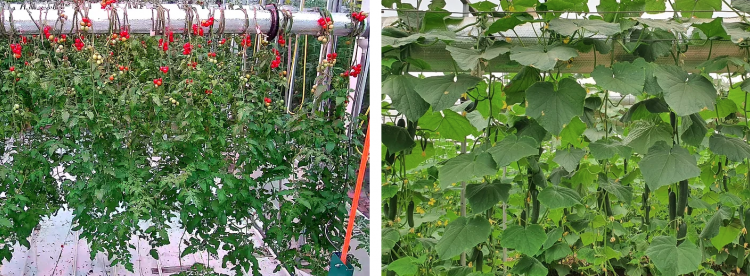The Israeli company BiomicAgritech is introducing an unusual technology for growing greenhouse crops. With the help of a patented plant, the company wants to reduce labor costs for growing greenhouse crops.
In tests conducted at the Dutch World Horti Center, tomatoes ripen on plants suspended from silver tubes. With this system, BiomicAgritech is not only trying to reduce labor costs in the greenhouse industry, but is also preparing to build a fully robotic greenhouse. The floor in the greenhouse is left empty and clean, so it can be covered with conveyors in the future. There will be no need for a machine to haul the crop, as a robotic arm running over cables over the crop can cut the fruit and place it on a conveyor belt in the packing area. The same manipulator will remove the leaves, which will also go directly to the composting area.
Currently developed by the Israeli team BiomicAgritech, the system consists of trellis vegetables growing from top to bottom from rotating tubes. Tapestry planting is excluded in principle, it is carried out under the action of gravity, and tilts and lowering are replaced by winding bare plant stems on tubes by rotating the tubes at the touch of a button.
A similar setup was also tested on cucumbers. When growing cucumbers, trellis work is even more significant because of the delicate nature of cucumber stems.
On the test in the Netherlands, the developers kept the growing parameters similar to the traditional ones. For example, they planted plants at a distance of about 30 cm, and even kept similar lighting systems from above, although in the future they have thoughts about additional lighting.
Plants are grown in a pipe, which also contains the substrate and irrigation system. The plant begins to grow upward to the point where the stem cannot support the weight of the plant, the stem bends and the plant grows downward. As the plants approach the floor, the pipe is raised, then the plants continue to grow, the system is raised higher, and when the plants grow even larger after harvest, the pipes are turned and wrapped with stems.
The first goal of developers is to reduce labor costs. In all trials, labor savings amounted to more than one-third of the labor costs for cultivation. As one greenhouse grower in Israel noted, even if the harvest is smaller, solving the labor problem brings the greatest benefit, since the process of finding and hiring people is accompanied by a “big headache.” When growing cucumbers, labor costs are even higher, since they have to put up trellises almost every second day.
In addition to reducing labor costs, inverted growing promotes sustainability. Since the plants are not tied to the trellis, there are no plastic wires or devices for tying and lowering. After uprooting the plants, pure compost material remains. In addition, without a trellis, viruses are less transmitted because the plants are less touched by a person.
The company is now actively seeking funding to realize its long-term vision of fully robotic greenhouses, as well as open-minded growers ready to build plots of around 500 sq. m to experience the benefits of this method and see the real benefits of growing upside down.










